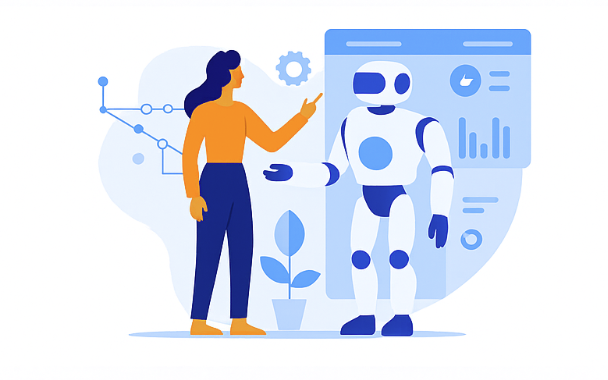
The Trust Paradox
Artificial intelligence has quietly become the backbone of modern manufacturing optimizing workflows, predicting failures, and accelerating product release cycles. Yet in highly regulated sectors such as pharmaceuticals or medical devices, autonomy comes at a price.
Machine learning models are not only powerful but opaque; they learn from dynamic data, adapt to the fly, and sometimes make decisions that even their creators cannot easily explain. Regulators, however, expect determinism, traceability, and evidence. In Good Manufacturing Practice (GMP) environments, every change must be justified and every action attributable. So, the real challenge is not “Can AI help ensure compliance?” but “Can AI itself comply?”
Trust must now be designed- not assumed.
From Automation to Accountability
Early automation was predictable. Validation engineers wrote scripts; quality teams verified outputs. Systems did what they were told. But today’s AI doesn’t just execute interprets, classifies, and predicts. When an algorithm flags a deviation or auto-generates test evidence, auditors will eventually ask: Who verified this result? What was the training data? When was the model last validated?
This transition marks a new phase: from automation to accountability. Validation is no longer a one-time milestone but an ongoing discipline of continuous assurance. The lifecycle now includes model qualification, periodic retraining reviews, and rollback triggers if drift or bias is detected. In Global manufacturers, such governance layers are becoming standard practice combining AI dashboards with human checkpoints so that no system learns in the dark.
Designing Human-Centered AI for GMP
A human-centered approach begins with humility: machines can process data faster, but humans interpret context better.
Human-in-the-Loop (HITL) design keeps experts embedded in the AI workflow approving models, reviewing anomalies, and defining the “safe zone” of automation. This structure ensures compliance with 21 CFR Part 11 and EU Annex 11, both of which require clear boundaries between human decision-making and automated control.
Core principles include:
- Defined roles and segregation of duties: Engineers train; QA verifies; management approves.
- Explainable outputs: Each AI decision must be traceable to logic that auditors can understand.
- Governance boundaries: Model-risk tiers and escalation workflows are documented in the validation master plan.
- Immutable audit trails: Every decision, retraining, and override is logged with timestamps and digital signatures.
Human-centered AI therefore turns compliance into a design feature, not a constraint.
Cross-Industry Lessons in Digital Trust
Pharma is not the first to balance automation and accountability. Other regulated domains have built digital-trust frameworks that pharma can emulate.
- Aerospace: Predictive maintenance algorithms on jet engines require human certification before software deployment; any model drift triggers a revalidation cycle.
- MedTech: Diagnostic AI tools use “clinician-in-command” architectures where physicians validate AI outputs before system updates.
- Finance: Anti-money-laundering platforms operate under dual-control rules and algorithms detect anomalies, but compliance officers approve actions.
These parallels show that the key to digital trust is visible human oversight. In GMP terms, this means preserving ALCOA+ data principles Attributable, Legible, Contemporaneous, Original, Accurate, plus Complete, Consistent, Enduring, and Available.
Trust is not created by perfect code; it is created by accountable people using transparent systems.
A Framework for AI Accountability in Regulated Environments
Building sustainable trust requires structure. The following Five-Pillar Model integrates AI governance into existing GAMP 5 (2nd Edition) and CSA expectations.
| Pillar | Description |
| Responsible Data Pipelines | Capture data provenance, enforce labeling standards, and restrict access through validated interfaces. Every dataset should have an owner and an expiration policy. |
| Transparent Model Governance | Document model purpose, logic, and performance limits. Store metadata for every version so auditors can reproduce historical results. |
| Human Oversight Loops | Embed human review stages for approvals, overrides, and periodic checks. Define who signs off before production use. |
| Continuous Performance Monitoring | Track key metrics—false-positive rates, drift, accuracy decay. Trigger alerts and corrective actions automatically. |
| Revalidation and Rollback Mechanisms | Establish thresholds that require requalification. Maintain a tested rollback path to previous versions to ensure uninterrupted compliance. |
Together, these pillars transform validation from a reactive activity into a self-auditing ecosystem where digital trust is continuously demonstrated.
Bridging Compliance and Innovation
Many companies still see compliance as a brake on innovation. But with AI-driven validation, compliance can actually accelerate progress when built into design. A pharmaceutical firm deploying a paperless validation platform recently found that integrating CSA principles with AI-based document classification cut their review time by 35 percent without compromising auditability.
This success came from cross-functional alignment: engineers, data scientists, and QA professionals worked together to define what “trustworthy automation” meant for them. The outcome wasn’t merely faster approval cycles it was a stronger compliance culture that embraced transparency and data ethics as competitive advantages.
The Policy Horizon
Regulators are also adapting. The FDA’s Computer Software Assurance (CSA) draft guidance encourages risk-based validation favoring evidence of control over excessive documentation. Meanwhile, the EU AI Act and NIST AI Risk-Management Framework emphasize human accountability and continuous oversight. These initiatives converge on a single message: compliance in the age of AI is not about proving perfection, it’s about proving control.
Organizations that adopt human-centered AI now will be better positioned to demonstrate both innovation and integrity when new rules become mandatory.
The Cultural Shift: People Before Platforms
Technology alone cannot create trust; people must.
Digital transformation succeeds when quality, IT, and operations teams share ownership of governance.
Training programs should go beyond software tutorials to include ethics, bias awareness, and human-machine collaboration principles.
When employees see themselves not as validators of systems but as stewards of digital trust, compliance becomes intrinsic to daily operations.
As one validation lead observed, “Our aim isn’t to make humans obsolete it’s to make their judgment auditable.”
Conclusion: Designing for Digital Trust
The next evolution of GMP compliance will be defined not by more algorithms but by smarter oversight.
Human-centered AI brings accountability, transparency, and trust into every layer of digital validation.
In regulated manufacturing, the most advanced system is not the one that automates everything, it’s the one that keeps humans responsible in control.
In the era of Pharma 4.0, trust is no longer a byproduct of compliance, it is the core deliverable of the digital enterprise.
Author’s bio
Manaliben Y. Amin is a CQV and Digital Systems Specialist with over 10 years of experience in pharmaceutical validation and digital quality systems. She leads large-scale paperless validation and compliance initiatives across GMP-regulated environments. Her expertise spans commissioning and qualification (C&Q), Computer Software Assurance (CSA), digital validation platforms, and GAMP-based transformation programs. She is recognized for driving risk-based, technology-enabled approaches that enhance data integrity, lifecycle management, and operational efficiency in regulated manufacturing.




